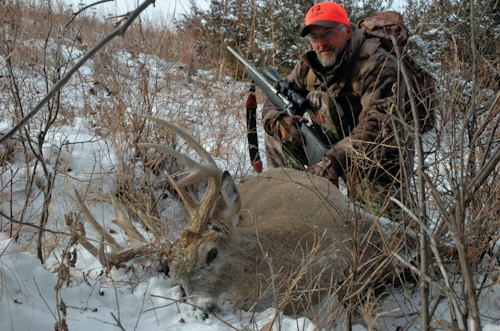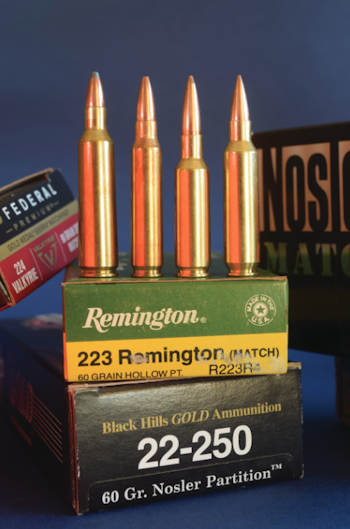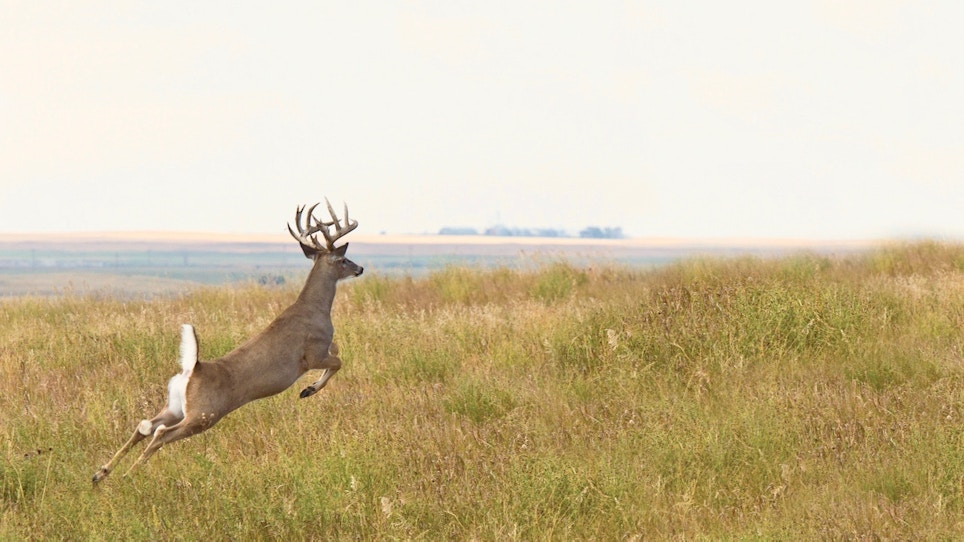Ed Broder and two pals spent most of a November day herding their 1914 Model T the 100 snowy miles from Edmonton to Chip Lake, Alberta. At a local sawmill, they hired a team of horses and a sleigh for the final pull. At the cabin, Broder took up his .32 Special and trudged into the woods. A big track led him half a mile to a fresh bed, then through a swamp. He dismissed a fresh moose track. The deer would be quicker to find in the fading light. Continuing, he spied the buck in a clearing. His shot felled it. A century later, Ed Broder’s mule deer still tops its category in Boone and Crockett records.
Jim Jordan had fortune to match, but almost let his prize slip away. November 20, 1914 dawned cold on Wisconsin’s Yellow River. Jordan picked up whitetail prints near the Soo Line, just out of Danbury. Farther along, several deer suddenly burst from tall grass. Three shots failed to drop the buck. With one cartridge left, he trailed the animal. A careful shot across the river dropped it. Returning with help, he had to look again for his deer, which had washed downstream. After engaging a taxidermist, Jordan lost the buck for the third time, and almost forever! In 1959, a Minnesota pawnshop sold the antlers for $2. In 1978 Jim Jordan was finally credited for his world-record whitetail, two months after he died.

A deer's reaction to a shot depends somewhat on the punch delivered. Though the .32 Special dates to 1895, its 170-grain bullet hits much harder than the 86-grain softnose from a .25-20. Still, even the biggest bucks aren’t toppled by raw ballistic muscle. Indeed, knockdown power is a myth.
Big game falls down when a bullet shatters supporting bone or when vital organs fail. Long ago, a fellow reportedly tested the blow of the then-new .458 Winchester by holding a thick steel plate in front of him on the edge of a table — while an equally heedless amigo fired a 500-grain softnose into the plate. It absorbed the 2 ½ tons of energy without flattening the man gripping it. Yet it upends elephants.
A deer that drops as if the earth were jerked from under it may indeed be dead. But you’re smart to stay in position, loaded and ready to fire again. Sudden collapse can indicate a shattered spinal process. Smashing one of those projecting bones transmits shock through the spinal cord. But with the cord intact, the animal may recover in seconds. Once it has its legs, you’ll have to fire again, right away.
Two weeks ago at this writing, I shared camp with a hunter after his first elk. His guide called in a bull that posed obligingly at 90 yards, and dropped at the report of the hunter’s rifle. The hunter jumped up. But so did the elk. Another hurried shot floored it. Instead of topping off his magazine and easing ahead, the hunter reversed course, dashing back to celebrate with his guide. At last, the two strode toward the beast they were certain had expired, approaching from the front. When the elk saw them, it rose and galloped off. The astonished hunter fired without effect.
Knockdown power is a myth.”
While elk are famously durable, a deer might well have delivered the same surprise. Squandering a steady shooting position by sprinting forward, this hunter erred too in turning back. His focus should have stayed on the elk until a touch of his rifle muzzle confirmed its demise. He should have approached from behind, where the beast couldn’t see and where a finishing shot would have been easy.
I typically wait a full minute, rifle aimed and ready, after a deer has dropped. Sometimes a minute isn’t enough. A pal once waited hours for a shot at a buck bedded across a canyon. He fashioned a rest for his rifle and checked the wind and yardage many times. When at last the deer rose, it fell promptly to the shot. My friend watched the motionless antlers, all he could see. At last, he descended into the canyon and climbed up the other side to retrieve his prize. It was gone, a spot of blood sole evidence of the drama.
Where did his bullet and the bullet fired by the elk hunter strike? Most hunting outfitters I’ve talked with agree that more errant shots go high than low. Clipping the crest of the spine is common. So are shots just under it. Typically, such shots cause little hemorrhage, and much of the blood that leaks is held back by hair and the curve of the ribs. The beast is unlikely to die soon. This is true even if it initially wilts to the report.

In southern Africa, professional hunters urge clients to shoot for the shoulder, not behind it. This is partly because many animals commonly sought on safari don’t share a whitetail’s anatomy. Their lungs lie well forward. Bullets that land a hand’s width behind the crease may not kill quickly. Then too, shoulders support the body. Shattered above or below the knuckle, a shoulder cannot bear weight. Nor will any game long survive if shards from bullet and scapula shred its vitals.
Shots just behind the shoulder have won favor stateside because they pulp a deer’s lungs without blasting bone chips into venison. Animal reaction varies. Frangible, fast-stepping, missiles may down the deer instantly. Traditional softpoints at modest speeds, as from the .30-30, typically produce less dramatic effect — as do stoutly built bullets from friskier rounds. The animal moves off, but dies within a few yards.
Shots just behind the shoulder have won favor stateside because they pulp a deer’s lungs without blasting bone chips into venison. ”
Once, I crept up on a whitetail and fired my .300 Savage through a slot in the timber. The buck dashed off. Looking for blood, I found none. The tracks, sharp and deep for a few yards, vanished in thick grass and other deer prints. On hands and knees, I spied a hair and a speck of pink flesh. Lung! Trailing with my face inches from the ground, I followed a hunch, taking a faint cross-path where the tracks faded. The buck lay dead mere feet away. It had covered the first 30 yards so fast it left no blood. Years earlier, a deer had almost lost me by hooking into a tunnel in a blackberry tangle before succumbing.
Recovery often hinges on your calling the shot and reading the beast’s reaction accurately. Don’t expect buckets of blood. I’ve found many animals dead on a “dry trail.” And don’t expect every stricken deer to drop its flag, stay with a group, run downhill or mindlessly careen straight down a trail.
Sound can tell you much about a hit. You may hear nothing up close, where the shot or its echo overlaps impact. Downrange, the strike comes later to ear, partly because it happens later, partly because the sound must cover the distance back, at about 1,100 fps. I like to hear a solid “thwack” — clue to a hit in the forward ribs. A sharp crack may mean a broken leg, or a strike to a spinal process. A sodden thump signals a paunch hit — all but confirmed if the deer kicks at its belly and runs flat, head down. You may see a kick in response to lung and heart shots; but in such cases, the hoof typically reaches well forward.
The key to short blood trails is precise bullet placement. My rule: fire only when 90 percent sure of a lethal strike — that is, when under prevailing conditions I could put a bullet in the vitals nine times in 10 tries. Surely, you’ve heard: “With bullets in the air, there’s hope.” At best, this is brainless optimism. It brings to mind my boyhood, when with a lemonwood bow I hurled cedar arrows into swarms of starlings passing overhead. An occasional gap in those flocks was as close as I came to a hit. Hope won’t kill deer. Unless you correct your hold or take more care, you’re no more apt to kill with a second bullet than with the first. Moreover, errant shots are as likely to cripple as to miss.
One evening in the mountains, on the cusp of a November storm, I chanced upon a bedded buck quartering away. My .30-06 bullet ranged forward. The deer bounded downhill as heavy snow began to fall. I got another crack just as the buck entered timber, and again heard the bullet strike. Now a blizzard, the snow precluded a wait. I scrambled to where the animal had vanished, my own tracks buried almost as soon as they appeared. There was no trail to follow; I let my feet lead through a close curtain of popcorn-size flakes. Brushing a boulder, I loosed its quilt of snow and saw the rock was blood-soaked. Minutes later nightfall ended my hunt. The next morning, I climbed to continue my probe. Snow topped my boots. The deer, assuredly dead soon after the shooting, was lost. Under almost any other conditions, it would have been recovered. The failing was mine alone. No one else pulled the trigger.

Confirming the result of every shot, then finding fatally-hit game strike me as ethical imperatives. Guiding hunters for a about a decade, I met people who didn’t share that view. One fired at a deer across a timbered draw. The animal reacted instantly. To hunters who’ve noted both, the split-second delay of a startled deer seems a pause unto eternity compared to a stricken beast’s on-impact leap. “Let’s find your buck,” I said. The hunter replied that he’d probably missed.
Even if I had thought so, we’d have searched. It’s what responsible people do after perforating living creatures. Perhaps this man lacked the ambition to cross the draw; or he wanted to seek a bigger buck. I cannot say. Gently I told him this animal, dead or alive, was our priority. “You made it so when you fired.” Tracks showed where the buck had jumped. They led me to his deer, dead, 20 yards away.
Not every deer will be down when you find it. A couple of seasons ago, I prowled oak-studded hummocks above a wooded swamp. A whitetail buck with fine antlers emerged from a cedar copse. Old Savage .25-35 in hand, I ducked into a hollow, and then hurried forward. My only shot came at 80 yards on swamp’s hem. The front blade found rib, and a .25-35 bullet was on its way. It struck audibly. The buck flagged off as if untouched. Glassing the wall of cover revealed nothing, so I eased ahead. Patchy snow revealed prints. Yards on, the sun winked on a drop of crimson. Nevertheless, the buck had been quartering away, and my little bullet had surely stopped inside. Then, by great good luck, the fringe of a deer’s tail caught my eye. The buck was standing. It fell at the report, but I fired again, because offhand is unsteady.
While only sunrise-certain shots make sense when you send your first bullet at a deer, a hit shifts that standard. You’re obliged to take every chance for a finishing shot. When in doubt, or even if you’re sure the deer will soon collapse, fire again. There’s no better use for bullets.
One night long ago, the headlamps of my Peterbilt log truck picked movement from roadside. A mule deer doe struggled to rise. On the brink of starvation, she couldn’t. A hunter had shot off her jaw. I crushed her skull with a hammer.”
Some hunters have told me they aim for the neck, because “a shot there drops ‘em right away.” If the bullet smashes the spine, they’re right. But vertebrae snake elusively through other tissue comprising most of the neck’s bulk. Bullets that tear muscle, esophagus and windpipe won’t anchor a deer. It will run off, infection finishing what you started, days later.
Ditto for headshots, despite claims that bullets aimed at the noggin “either kill or miss.” There’s a lot of non-vital tissue surrounding the baseball-size brain of a deer. How often, at deer-hunting distances and under field conditions, can you be certain of hitting a baseball? One night long ago, the headlamps of my Peterbilt log truck picked movement from roadside. A mule deer doe struggled to rise. On the brink of starvation, she couldn’t. A hunter had shot off her jaw. I crushed her skull with a hammer. Many seasons later, hunting, I glassed a buck with an odd appendage fronting its throat. On close approach, I saw it was the jaw, hinge shattered by a bullet. My shot ended the poor animal’s suffering.
The vital organs between a whitetail’s shoulders are a big target — at least the size of a soccer ball from the side. A suitable bullet sent there should end your hunt. The deer’s reaction, and your behavior, affect only the recovery.
The Long Poke
Long shooting hikes the odds you’ll miss or cripple, and often limits your chance for follow-ups. Bullet trajectories get steeper (and range reads more critical) far away. Wind has greater effect. Distance multiplies error in your shooting routine and delays your finding the animal’s trail. Every year, bucks that draw fire across canyons are lost by hunters who don’t bother to check the results of their barrage.
While getting close is no guarantee you’ll make a perfect shot (I once missed a buck at 14 feet!), the shorter the poke, the more likely you’ll make it good. Close sneaks also test you as a hunter, not just a marksman. The rewards match the challenge. You’ll long remember hunts that brought you near enough to make double-lung hits offhand with iron sights!
Bullets: How Big Is Big Enough?
The .22 Nosler and Federal’s .224 Valkyrie have revived interest in using .22 centerfire rifles for deer. In 1905, Charles Newton necked the .28-30 Stevens to .22, a step toward his .22 High-Power, on the .25-35 hull. Hunters hailed the High Power for its lightning-bolt effect on deer. Newton developed the .250 (.250/3000) Savage in 1913. Like the .243 Winchester and .244 (6mm) Remington that appeared four decades later, it sped 100-grain bullets along flat arcs.


Roy Chapman Andrews, who hunted on his expeditions for the American Museum of Natural History, called it “the most wonderful cartridge ever developed.” By the 1930s, wildcatters had .22s on the .250 case. The 1937 version by Gebby and Smith became the “Varminter.” Even before Remington adopted it in 1965, this .22-250 steadily eclipsed the .220 Swift at market. While not everywhere legal for deer, it has become a sure killer with heavy bullets, 64-grain spitzers at 3,500 fps bringing more energy to 100 yards than does the .32 Special with 170-grain softpoints! Indeed, the less capable .223 can deliver more than double the punch of the .44-40 with 200-grain bullets, and three times that of the .25-20 that toppled the Jordan buck! The remarkable success of such loads on deer owes much to their mild recoil — as poor shooting follows flinch-inducing kick!






